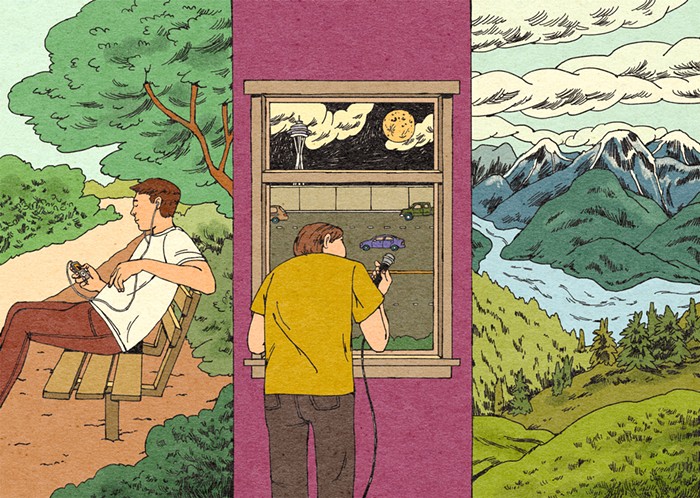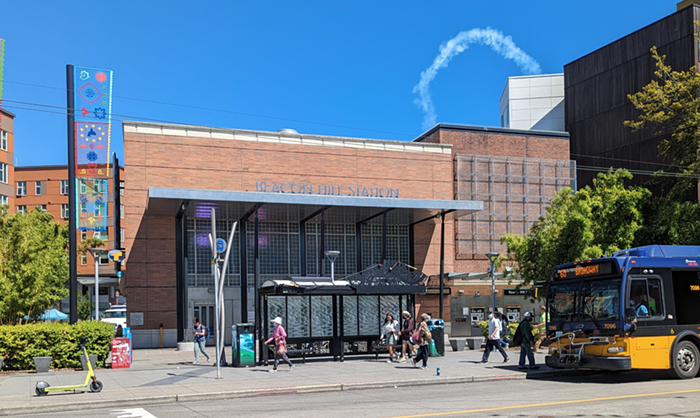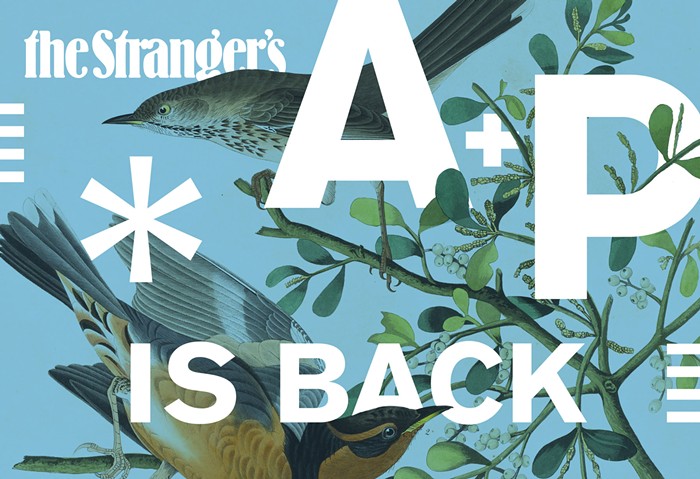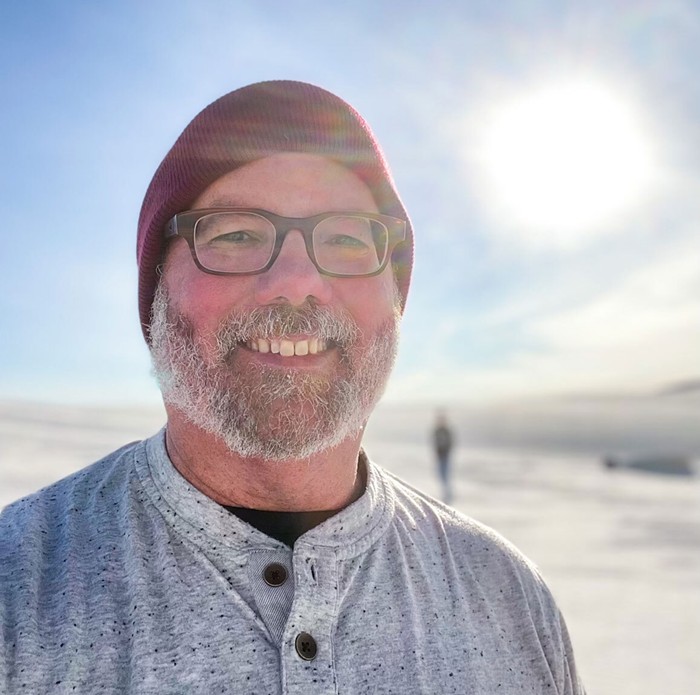Jeffry Mitchell's art is ejaculatory, in every good and holy and dirty and wrong sense of the word. We are discussing this at church. Actually, we are outside church; we've just come from the pews of St. Ignatius at Seattle University, where we lifted our eyes up to the half-naked, tortured, and dead Christ, and kept quiet. We weren't there to worship, but we weren't there in disrespect. Mitchell took the holy water on the way in. Now back outside, he talks about his intimate, lifelong relationship with a religion that casts him out for being gay. "What they tell you in there is that you're supposed to be good to everybody—and they bind you up and put you in a chair and beat it into you," he says and laughs warmly.
Mitchell is sweet, not bitter. He is soft. And very smart. "The whole Catholic thing is very kinky. The ritual. The gore and the glam. It's very gay. This whole thing about the devil being external, and the fear that the devil will become internal—the fear that it is trying to get in, when we all know the devil is internal all along." Things going in, things coming out, exuberance, vulnerability: ejaculation. Mitchell's art is urgent. It has the appearance of having been made in a hurry, even though it's heaps of clay that have been shaped and fired and glazed and fired again, or accumulated layers of ornately cut paper, or a page overgrown with curly line drawings of peonies, cherry blossoms, bears, elephants doing handstands, pickle jars, trees, turtles getting married, the words "HELLO HELLO," four-leaf clovers, lotus flowers, horseshoes for good luck. Earlier this year I named his 2007 Pickle Jar with Silver Elephants one of the 25 greatest works of art ever made in Seattle: "These are fat fleshy loops made out of breakable ceramic, coated—but only coated, and only lightly—in the refinement of pretty white and platinum luster. Underneath, in the earthenware itself, unperfected finger pinches and crude little marks are still visible: There's always the memory of softness. Instead of irony there is wonder, humor, humility, and a warmth so intense you may as well call it love. Actually, that's it: No other Seattle artist has come close to producing as much sheer love as Jeffry Mitchell."
Urge and urge and urge,
Always the procreant urge of the world.
Even without this prompt from "Song of Myself"—Mitchell is Walt Whitman, in many ways—Mitchell says: "Allow, allow, allow. That's my mantra." He's taking back the right to pleasure. Another mantra of his: "I want it to be possible to pray."
We drive to a second church, this one more traditional and with a mass in session. It's St. Joseph on Capitol Hill. Mitchell chose it because he loves the no-frills cast concrete of the building against the explosive sparkle of the stained-glass rose window above the altar. "We have budget needs," the priest says into his clip-on microphone. "Pledge yourselves to this parish. If we don't receive the resources, we're going to cut personnel, we're going to cut services."
Mitchell is preoccupied by the sides of the church. They are lined by triple wooden chambers where you wait in the dark for a shadow of a priest: confessionals. "Scary," he whispers.
"Roy McMakin [another Seattle artist] recently asked me, 'What are you doing? What is it really about?'" Mitchell says, outside again. "And I told him: I'm trying to negotiate fear. I'm trying to get in touch with my feelings and impulses and honor them without being afraid. That's what I've always tried to do, I think—tried not to be afraid. It's an endless battle."
At 51, Mitchell is a Seattle art eminence. He has crazy bona fides for someone who lives in a drafty basement and waits tables at the Boat Street Cafe. He's had solo shows at the New Museum in New York (the legendary late director Marcia Tucker handpicked him herself), Seattle Art Museum, and Henry Art Gallery. He continuously innovates. This year alone, he settled in among the masters of contemporary ceramics in the show "Dirt on Delight" at the Institute of Contemporary Art, Philadelphia. Artforum recommended his Portland show with McMakin. He made two new—and entirely different—bodies of work for solo shows at James Harris Gallery in Seattle and the University of Puget Sound in Tacoma (one a profusion of clay pots and a quiet handful of fine drawings of flowers, the other a playground of cut paper and spray paint and shadows). He organized a group exhibition at Crawl Space, contributed new works to shows at Howard House and Ambach & Rice, wrote an eloquent essay on McMakin (not an easy task, since Mitchell is dyslexic), and shows up to everything—talks, workshops, openings, you name it—with his gap-toothed smile shining. He resembles Philip Seymour Hoffman, so much so that another Seattle artist, Ellen Ziegler, made a faux movie poster adapted from a New York Times Magazine cover featuring Hoffman: "Philip Seymour Hoffman in The Jeffry Mitchell Story," the headline read. "Original score by Elton John."
Born in 1958, he was the fourth of nine children in a caravan of a Catholic family that relocated every couple of years, blowing around the small, tough-guy, air-force-base towns of the American West. They were not miserable, but they were poor and they were a crowd. ("There's still something very class-specific about what I do, things that have to do with my own insecurity about being poor, and yet I also see how poor people really limit themselves by wanting to tear down the culture of affluence—the fucked-upness of Catholicism, the heroics of martyrdom, the problems of celebrating suffering," Mitchell says.) Both parents were born and raised in West Seattle; his father, whom Mitchell describes as a compassionate company man, worked for Boeing. Mitchell graduated from high school in Minot, North Dakota, then went to college at the "completely-out-of-their-minds-conservative" University of Dallas in Irving, Texas, where he studied with painter Robert Cardwell, a Vietnam vet who made hard-edged geometric paintings as if his life depended on it. When he returned to Seattle, he worked briefly for Boeing: facilities maintenance. Boeing insurance meant he could finally get his kneecaps fixed. He was born with dislocated kneecaps, so he always had to move hesitantly, afraid they'd go out. Later, his ceramic men and animals would share this awkward top-heaviness.
Above all, he was tormented and celibate during these years. He went to Japan to teach English, stayed on to study with a potter and to take calligraphy lessons from the neighborhood butcher's wife. At this point he considered himself an artist. But it wasn't until he was back in the U.S., at graduate school at Tyler School of Art, that he came out, finally, at age 28. Talking about it still makes him sob. "Afterward, it was like I only had to step over this smallest fence," he says quietly.
If Mitchell were straight, he wouldn't be an artist.
"Feeling outside of things makes you make up shit to cope, and that creativity becomes your strength," he says. "So I think being queer, of course, is a huge gift. That weird trauma of being queer ends up being your salvation, but it's the impression you're always stuck with or trying to manage or negotiate."
Art hasn't always been enough. Mitchell rode over rocky ground to get here, through abusive boyfriends and drugs. In 2006 he made his most sorrowful work, a replica of a Seattle sex club he visited while he was strung out, created in the pure white of funeral flowers. He used ceramics and a folding screen made of cast paper, and called it The Tomb of Club Z. It stood alone in a room at Western Bridge, glowing and aching like a pietà.
In a workshop Mitchell led recently with other artists at Seattle University, he initiated a big group painting that said "HELLO HELLO" at the top with the smaller words "Bye Negativity" scrawled underneath. Coming from Mitchell, it didn't seem cheesy, just direct and timely. Mitchell seems to have entered a period in which he responds to the prospect of degradation with unveiling rather than armor, in both his work and his life. It takes courage but looks nothing like courage, like a Taoist idea: "The softest thing in the world overcomes the hardest."
Allow, allow, allow. ![]()













